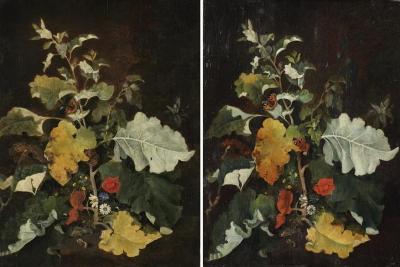Crome and copies

Crome worked as a drawing master throughout his life, encouraging his pupils to copy their teacher's work, or the work of other artists.
On the left of this image is 'Study of a Burdock' by John Crome, c.1813. The right image is a student's copy. The difference is subtle; the student's version is slightly less spontaneous - the main stem is not so gently curved and the flora is sharper and more solid-looking.

Crome's reputation has long been beset by attribution problems. He did not sign or date his paintings, spent twenty-five years teaching pupils to draw by copying his work and was in the habit of lending them works for copying and studying. His style was emulated by followers, his apprentices worked on his canvases, his eldest son had a similar style and name, unfinished paintings were left in his studio when he died and Alfred George Stannard claimed to have painted 'over 300 Cromes'.
By the late 1840s a mix of misattributed works, genuine copies and forgeries of Crome's works had started to appear on the market, at least locally. However, prices remained low until seven of his works were included in the 1862 International Exhibition and 'Mousehold Heath, Norwich' was purchased by the National Gallery, the first Crome painting to enter a national collection. The National Gallery's purchase of 'Mousehold Heath, Norwich' was deemed by 'The Athenaeum' as deserving 'special comment': 'Crome's inimitable landscape, "Mousehold Heath" ... delighted everybody at the International Exhibition, and taught gallery-loungers that there had existed a perfect landscape-painter who was out of their ken. The state of popular ignorance about Crome was made plain by the fact that until May last scarcely any one had heard of him.'

Crome's prices rose after the National Gallery purchase and led to deliberate forgeries flooding the market. The first report of an issue with the authenticity of Crome's work in the national press appeared in 1869 when 'The Times' and 'The Art Journal' reported on the trial of Mordaunt v. Palmer. The plaintiff, a Sheffield art dealer, complained that the defendant had knowingly sold him forged works 'by Crome, Prout, Roberts, Stanfield, Pearson, Fielding, De Wint and other celebrated painters'. By the 1880s the harmful effect of readily available Crome forgeries warranted a mention in 'The Standard': 'Quite lately there was a manufactory of Cromes. Cromes of the second class - the work of the copyist and the imitator - could be supplied in any numbers. They were always offered as surprising numbers. And they have done something to discredit him.'





